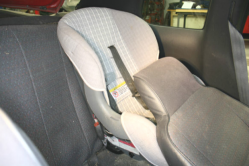
— Two U.S. senators want to know what automakers are doing to protect backseat occupants from front seatbacks collapsing and striking children sitting in the back.
Senators Ed Markey (D-Mass.) and Richard Blumenthal (D-Conn.) sent letters to 17 automakers requesting detailed information about the problems caused by front seatbacks collapsing in rear-end crashes, including the strength of their seating systems and the number of known seatback collapse incidents.
The senators sent letters to the following 17 automakers:
- Audi of America
- BMW North America
- Fiat Chrysler
- Ford Motor Company
- General Motors
- Honda Motor
- Hyundai Motors
- Jaguar Land Rover
- Mazda North America
- Mercedes-Benz
- Mitsubishi
- Nissan North America
- Porsche
- Subaru Motors
- Toyota
- Volkswagen
- Volvo
The problem primarily occurs in a rear-end crash where the car in front experiences crash forces that cause the front seatback to collapse toward the rear seat. The backseat is where consumers are taught to put child passengers, an allegedly safer place for children. However, those children can easily be injured or killed by the impact from the collapsing front seatback.
According to a study commissioned by the Center for Auto Safety, approximately 50 children placed behind occupied seats have died annually in rear impact incidents over the last 15 years.
Automakers argue their seats meet or surpass federal safety standards, but safety standards are so weak a simple lawn chair could pass the tests. The two senators say the problem is found in the seat standards, regulations that are outdated and haven't been substantially updated since 1967.
The automakers also claim the seats work as designed because the seatbacks should easily collapse backward to protect the front-seat occupants. The goal is to absorb crash impact forces to protect the front occupants, but in reaching that goal the backseat occupants can be left vulnerable from the front seatback.
In the letters, each automaker is asked a series of questions concerning seatback incidents and what the automaker is doing to protect against the threat posed by collapsing seatbacks.
One of the questions is this: "Has your company ever been involved in a lawsuit for an incident that alleged front seatback failure?"
Audi is one of the automakers asked to answer that question, so the automaker will likely mention a case involving a 2005 Audi A4 Quattro. Audi was sued by the family of an 11-year-old boy who was seriously injured when a vehicle struck the Audi from behind.
The 2012 accident occurred when the driver, Jesse Rivera Sr., stopped the Audi A4 Quattro to wait for a school bus that was stopped to pick up children. His son was sitting directly behind him when the Audi was hit from behind, causing Mr. Rivera Sr. to fly backward as the seatback collapsed.
Rivera Sr. suffered head injuries when his head hit his son's head, but it was Jesse Jr. who suffered the real damage. The accident caused the boy, then age 7, to suffer partial blindness, a skull fracture with permanent brain damage and partial paralysis.
Attorneys for Audi argued the seat worked exactly as designed to absorb crash force energy, but the jury still awarded the family $124.5 million.
Because the front seats are currently designed to fall back in the event of a rear-end crash, every automaker has faced complaints about seatbacks flying backward in a crash.
"Vehicle was rearended. Upon impact driver's seatback collapsed into rear seat, resulting in minor injury." - 1996 Dodge Ram 1500 owner / Memphis, Tennessee
"During rear impact at 10 mph, the driver's side seatback broke, causing the seat to fall backward into the rear seat." - 1995 Plymouth Voyager / Farmingville, NY
"At 15-20 mph vehicle was hit in rear. Seatback broke and reclined backwards. Dealer will be notified. There were 2 injuries" - 1997 Dodge Caravan owner / Payson, Arizona
The Center for Auto Safety petitioned NHTSA to “take action to protect children riding in the rear seats of vehicles from the risk of being killed or severely injured when struck by a collapsing front seatback in a rear-end crash.”
The Center sent the petition saying federal standards are inadequate and should be updated to reflect the poor performance of seatbacks in a crash. Based on available data, from 1990 to 2014 there have been 898 child fatalities while seated in the rear behind a front seat occupant.
Watch what happens when a front seatback collapses in a rear-end crash test of a 2004 Ford Crown Victoria.




